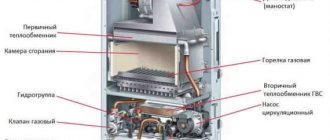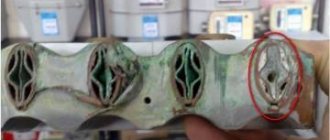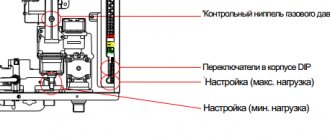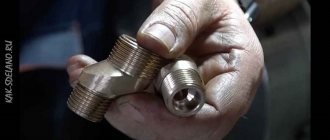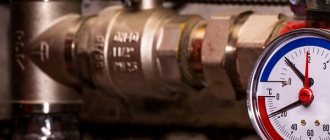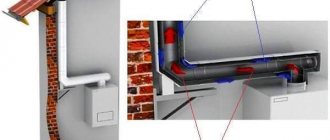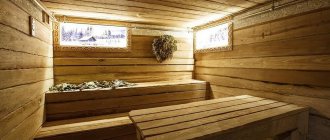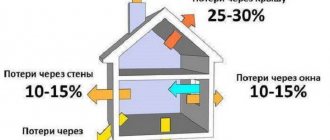Gas boiler heat exchanger material: which is better
It surprises me when people don’t think about the material from which the heat exchanger in the boiler is made. After all, this is one of the most important elements of heating equipment. The efficiency, heating rate and, most importantly, service life depend on the material. In addition, they may contain a second circuit. So that you understand which heat exchanger is better, I want to talk about the advantages and disadvantages of each of them.
The first cast iron heat exchangers
It was cast iron that was used to create the first coal and gas boilers. This is due to its anti-corrosion properties and service life of 30 to 50 years. And in general, cast iron has little effect on any chemicals. But as for the heat capacity, it is one of the highest. Therefore, even now, when many other types have appeared, cast iron heat exchangers continue to be in demand. They take longer to heat up, but also retain heat much longer after heating stops.
Secondly, they do not tolerate sudden temperature changes. But in heating, the return is always colder than the supply. Thirdly, in order to protect cast iron from these changes, they began to use special burners. And then heat capacity ceased to be an advantage. Therefore, in fact, the only advantage is a long service life.
Steel
To get rid of the disadvantages of cast iron, they began to use steel heat exchangers. They are lighter, the equipment takes up less space, and the price is much lower. In addition, steel heat exchangers are not so afraid of temperature changes, so they are very suitable as a heating element. And if they break, they can be repaired. Of course, not all models, but many.
Why then do cast iron heat exchangers continue to be used if steel ones have so many advantages? The fact is that not everything is so smooth. After all, steel is susceptible to corrosion, and this is a huge disadvantage. Therefore, the service life is 2-3 times less, usually from 12 to 15 years. I would also like to draw your attention to the fact that steel can burn out. If you decide to choose a boiler with a heat exchanger made of this material, I advise you to find out in advance about the wall thickness. It should be 3 mm or more. Or better yet, 5 mm.
Copper
The best metal in terms of heat transfer characteristics is copper. Perhaps, we can name only one disadvantage of copper heat exchangers. This is their high price; copper heat exchangers are usually installed on models in the mid-price segment and above (from 45-50 thousand rubles). But there are a lot of advantages:
By the way, it is precisely because of the rapid heating that much less gas is wasted, so savings can be considered another advantage. As for the service life, manufacturers usually indicate 14-17 years, which corresponds to reality. This is slightly more than steel, but still much less than cast iron. But during this time you will be able to save much more on fuel.
Typically, copper heat exchangers are installed in wall-mounted boilers. Although they are also found in floor ones.
Aluminum
Aluminum is also used as a material for the heat exchanger of a gas boiler. It was first used in condensation models, but I will talk about them a little later. Aluminum heat exchangers are also installed in conventional convection boilers. It would seem, why are they needed if copper copes well with its tasks? It's all about the price. To reduce the cost of production, in copper heat exchangers they try to reduce the wall thickness. There is no need to do this with aluminum. It is already several times cheaper than copper, and its heat transfer properties are also quite high.
It turns out that the aluminum heat exchanger is thicker than the copper one. And this is its huge advantage, because the service life increases. Practice has shown that aluminum is also less susceptible to oxidation. But on the Internet, opinions on this matter differ. Therefore, it is difficult to say exactly which heat exchanger is better.
We recommend: wall-mounted models - with a copper or aluminum heat exchanger; floor - with cast iron. Of course, budget models use exclusively steel.
Question about electric stove
Is there copper in an electric stove? This is a very pressing question for the owners of such devices in situations where they are deciding how to profitably hand over an electric stove that is no longer needed.
Typically, the wires of such plates contain copper conductors. Such core material is needed according to the aspects of the PUE. Depending on the number of cores and their thickness, the possible benefits of selling these products are determined. But this is still a very small benefit.
How much copper is in the electric stove itself? Not enough either. It can be found in moderate amounts in heating components. There may also be tungsten in there. The type of electric stove also matters. For example, in small models with 2 burners, copper heaters may occasionally be found.
Condensing boilers with additional heat exchanger
In conventional boilers, the burner heats the heat exchanger, and combustion products are removed through the chimney. But the point is that some of the heat also escapes through the chimney. To use this heat for heating, condensing boilers were created. Their design assumes the presence of an additional heat exchanger. It is structured quite complicated. Due to the temperature difference, condensation forms, which serves as a source of thermal energy. Roughly speaking, steam becomes water, it cools, and its heat is used for heating.
The idea of creating condensing boilers is not that new. This was thought about several decades ago. But then technology did not allow making a metal alloy that could work for a long time in an aggressive environment. Nowadays, high-quality stainless steel is usually used for these purposes.
Comparison of convection and condensing gas boilers Payback of condensing models in domestic conditions
Brass
Before using a brass heat exchanger, it is necessary to analyze the liquid with which the device will interact. Brass is used with fresh water without impurities and salts, otherwise the bundle of pipes will begin to rust and become unusable.
Despite the fact that the thermal and electrical conductivity of brass is lower than that of copper, it has a higher strength and corrosion resistance. Some brass alloys are resistant to sea water and superheated steam - their resistance to specific environments and conditions determines their scope of application. Moreover, brass is much cheaper than copper.
Monothermic or bithermic
When the boiler is capable of operating only in heating mode, it is called single-circuit. But many modern models are also capable of operating in hot water supply (DHW) mode. Such boilers are called double-circuit boilers. Water can be heated in two ways: using a plate heat exchanger or bithermic.
The plate heat exchanger is installed separately from the main one and consists of two parts. When heating water passes through one part, it heats the second, which is connected to the water supply. This is a separate, more practical and reliable, but more expensive and less compact method.
The bithermal heat exchanger cannot be cleaned mechanically and is quite difficult to rinse. When scale forms, it clogs faster.
In order to save money and space, dual or bithermal heat exchangers were invented. Their operating principle is completely different. Structurally, this is one piece: a heat exchanger in a heat exchanger or a pipe in a pipe. Heating is usually carried out outside, and a hot water supply circuit is located inside.
Unfortunately, due to their design, bithermal heat exchangers have narrow passages that can quickly become clogged. But cleaning doesn’t always help, and it’s not so easy to do. The price of such heat exchangers is much higher. And you will still have to use water for a limited time, since there is a risk of burning through the metal. I believe that it is better to buy boilers with separate heat exchangers. They are more reliable.
Heat exchanger of a gas boiler in section. The use of contaminated coolant and lack of regular cleaning led to serious consequences: serious overheating and almost complete clogging.
People buy a boiler for more than one year. In the worst case, it should last several years. And since the heat exchanger is an important part of any boiler, its selection must be approached carefully. It is also worth remembering that this is one of the most expensive and difficult to replace spare parts. It is better to monitor the correct operation of the equipment and service it annually than to pay extra money for repairs later.
Source
Specifics of scrapping slabs
This method is most beneficial for those owners who can independently deliver the slabs to the collection point for metal products. At the same time, you can grab other metal debris (if any ).
If you do not have your own transport, you can contact a company that removes scrap metal and pays for it. It is better to find a company with the most favorable financial conditions. As a rule, you pay for the product minus fees for the services of field specialists.
To successfully pull this off, you need to:
- Contact the selected company by phone or through the website. Submit an application for a visit from receptionists.
- Agree on the time of their visit, give the address.
They come and take the device. They can dismantle it themselves. The owner receives money for such change.
There are some subtleties here too. When registering, you must correctly fill out the necessary documents. The client must prove his identity with a passport or other suitable document.
Specialists will inspect and check the slab and the type of metal using special equipment. They weigh her. The possible presence of hazardous impurities and other elements is detected. Based on the checks, the final price is formed.
The client receives payment directly on the day of delivery.
How much does it cost to sell a gas stove for scrap? Here a lot depends on its weight and content. For example, the standard weight of a small stove is 50 kg. Prices vary in different cities and companies. Usually this range is 3000 – 9000 rubles.
The price of a gas stove for scrap metal can be much less. Especially if it is a modest model in terms of weight and content.
Difference in heat exchangers in gas boilers
One of the main parts of a gas boiler is the heat exchanger for the heating system. You should pay very close attention to it when choosing a gas boiler, since it is in it that the coolant will be heated, so it must be reliable and last its entire service life without breakdown.
Currently, there are two types of primary heat exchangers for the heating system used in traditional gas boilers, and more precisely, the materials for their manufacture, since they do not differ in principle and form. In the manufacture of the heat exchanger, material made of copper or aluminum alloy is used (for boiler equipment).
Malfunctions and repairs
Let's look at what malfunctions are typical for heat exchangers of gas boilers, and also figure out how to fix them yourself:
- A crack may appear on the heat exchanger. You can solder it yourself. Solder must be selected depending on the material from which the part is made.
- When the TO burns out, it can be “glued” with a copper or tin patch. Less commonly, people use can lids and other homemade items. The patches are secured using a riveter.
- If the unit is leaking, you can turn to cold welding to repair the damage.
- The unit must be periodically descaled so as not to cause problems with the operation of the unit. A hydrochemical cleaning method, manual or chemical, is used. The heat exchanger will need to be removed from the equipment before cleaning.
- To completely replace the heat exchanger, it is recommended to contact experienced specialists.
For a video review of a boiler with a cast iron heat exchanger, see the video below.
COPPER HEAT EXCHANGER
Copper heat exchangers are used in boilers because they have advantages over other materials such as steel and cast iron. Copper heat exchangers weigh less, transfer heat faster, and are less susceptible to corrosion than heat exchangers made of steel or cast iron. The service life of copper heat exchangers is usually 10-12 years.
The disadvantage of copper heat exchangers is:
Stainless steel
Stainless steel heat exchangers have maximum resistance to corrosion and are used in systems with liquids whose chemical composition is not suitable for copper or brass. This can be water with high acidity, hardness, alkalinity, and a high concentration of sulfates. Stainless steel is used to produce pipes through which salt water with various impurities will flow.
In addition, stainless steel combines the advantages of cast iron and steel: it is durable, immune to temperature changes and has low inertia. It also does not emit metal ions that color and pollute water and is more affordable.
It is important to remember that the choice of material for a heat exchanger depends on certain parameters and is individual in each case. This issue should be approached with special care so that the heat exchanger lasts as long and efficiently as possible.
You might be interested in:
about products
Source
Boiler heat exchanger material
The most common materials for the manufacture of heat exchangers for gas boilers are steel and cast iron in the case of floor-standing models, and copper and aluminum alloy in the case of wall-mounted gas boilers.
There is no definite answer that one material is bad in all respects, and the other is good. It all depends on the quality of the metal, its thickness, production culture, accuracy during loading and unloading operations and some other parameters.
It is a common belief that a cast iron heat exchanger is always better than a steel one. This is not entirely correct. Agree, both cast iron and steel come in different qualities. At the same time, heat exchangers from different manufacturers have different thicknesses.
Cast iron is less susceptible to corrosion; a cast iron heat exchanger is usually made thicker, which can have a positive effect on its service life. At the same time, a cast iron heat exchanger also has disadvantages. It is more fragile, and, therefore, there is a risk of microcracks forming during transportation and loading and unloading. In addition, during the operation of cast iron boilers when using hard water, due to the design features of cast iron heat exchangers and the properties of cast iron itself, over time they are destroyed as a result of local overheating. If we talk about steel boilers, they are lighter and are not very susceptible to shock during transportation. At the same time, if used incorrectly, the steel heat exchanger can corrode. But it is not very difficult to create normal operating conditions for a steel boiler. It is important that the temperature in the boiler does not fall below the “dew point” temperature. A good designer will always be able to create a system that will maximize the service life of the boiler.
Boiler heat exchanger material
340 279 Material of boiler heat exchangers Material of boiler heat exchangers Material of boiler heat exchangers 220 277 Material of boiler heat exchangers Material of boiler heat exchangers Material of boiler heat exchangers 830 1245 Material of boiler heat exchangers Material of boiler heat exchangers
For traditional wall-mounted gas boilers, copper heat exchangers that are fairly lightweight and resistant to corrosion are often used.
Condensing boilers have their own specifics and therefore they use heat exchangers made of aluminum alloy.
TIC "TEKHNODOM" offers you gas boilers
with steel heat exchanger Zhukovsky, Baxi
with copper heat exchanger Buderus, Vaillant
with aluminum alloy heat exchanger Baxi, Navien
Source
Specifics of scrapping slabs
This method is more beneficial to those owners who can, without the help of others, deliver the slabs to the collection point for metal products. At the same time, you can grab other iron debris (if any).
SEARCH FOR FINDS. Geyser! How much metal is in it? Aluminum cable - what is the yield of aluminum?
If you do not have your own transport, you can contact a company that removes scrap metal and pays for it. It is better to find a company with the most favorable financial conditions. As a rule, you pay for the product minus fees for the services of field specialists.
To successfully pull this off, you need to:
- Contact the selected company by phone or through the website. Submit an application for a visit from receptionists.
- Agree on the time of their visit, give the address.
They come and take the device. They can dismantle it themselves. The owner receives money for such change.
There are some subtleties here When registering, you must correctly fill out the necessary documents. The client must prove his identity with a passport or other suitable document.
Specialists will inspect and check the slab and the type of metal using special equipment. They weigh her. The possible presence of hazardous impurities and other elements is detected. Based on the checks, the final price is formed.
The client receives payment directly on the day of delivery.
How much does it cost to sell a gas stove for scrap? Here a lot depends on its weight and content. For example, the standard weight of a small stove is 50 kg. Prices vary in different cities and companies. Usually this range is 3000 – 9000 rubles.
The price of a gas stove for scrap metal can be much less. Especially if it is a modest model in terms of weight and content.
Which heat exchanger is better in a gas boiler
It all started with cast iron
A boiler with a cast-iron heat exchanger in combination with cast-iron radiators and a boiler connected to the boiler coped quite well with the task of heating the building and providing its residents with hot water. Firewood, coal, and petroleum products were used as fuel in the boilers, and the boiler had one or another firebox for a specific type of fuel. After the advent of gas, simple atmospheric gas burners began to be installed on cast-iron boilers; in this form, cast-iron boilers have survived to this day and, frankly speaking, are giving up their positions very reluctantly. A cast iron heat exchanger has many advantages (durability, high corrosion resistance, high heat capacity, etc.), but also has disadvantages (fragility, “fear” of a high temperature difference between supply and return, heavy weight, etc.). The advantages were used, the disadvantages were fought.
Why was it necessary to make some other ones instead of excellent cast iron heat exchangers?
Firstly, the price. A cast iron heat exchanger is expensive. We started making steel heat exchangers. Cheaper. In addition, steel is not so brittle and is less susceptible to temperature differences between the supply and return. But some useful properties of cast iron have disappeared - corrosion resistance, durability and high heat capacity. Steel heat exchangers can be called “budget”, but their efficiency is naturally lower.
Secondly, cast iron boilers and their accompanying boilers take up a lot of space and “do not fit well,” say, into an apartment. The problem of minimizing the size arose. It was decided to replace the voluminous boiler with a compact flow-through hot water heat exchanger. That is, now hot water is not stored for future use, but is heated as it flows through the heat exchanger. And since the amount of water flowing can be different, depending on how and how many taps are opened, and at the same time its temperature must be at a strictly specified value, then the power of the burner must be different depending on the need. So-called smoothly modulating burners have appeared, the power of which can change quite quickly from minimum to maximum values. Under these conditions, such a useful property of cast iron as a large heat capacity began to interfere: the temperature “adjusts” too slowly to rapidly changing conditions, and unwanted temperature fluctuations occur.
There is a need to have low-inertia heat exchangers
The most convenient material for them turned out to be copper. Copper is ductile, relatively cheap, has high manufacturability (the necessary parts can be made from it quite easily), and most importantly, it has low heat capacity and very high thermal conductivity - 20 times more than cast iron.
There are 2 ways to heat hot water in flow mode:
- “bithermic” (coaxial or double-circuit) heat exchanger, “pipe-in-pipe” type, in which either the water of the heating system is heated from the flame of the burner, or, if you open the hot water tap, the water of the domestic hot water system;
- a secondary DHW heat exchanger, in which DHW water, flowing through its secondary circuit of this heat exchanger, is heated by the water of the heating system, which, in turn, is heated by the burner flame in the primary (main) heat exchanger of the boiler and flows through the primary circuit of the secondary heat exchanger.
Secondary heat exchangers of boilers are usually made of stainless steel, primary (main) ones are made of copper. To increase corrosion resistance, copper heat exchangers are coated on the outside with a special protective layer.
All of the heat exchangers listed above and the boilers in which they are used have a common name - “traditional”. The main disadvantage of traditional boilers is the inability to use the so-called “latent heat of vaporization,” which literally “flies down the drain.” The fact is that as a result of the chemical reaction of combustion of hydrocarbon fuel, which includes gas, water is formed. The temperature of the flue gases leaving a traditional boiler is above 100 o C, therefore, the water in them is in a vapor state and, “taking” with it more than 10% of the total energy obtained from burning fuel, goes through the chimney into the atmosphere.
Humanity has long dreamed of “harnessing” the energy of condensate. But for a long time, the main obstacle on this path was that condensation corroded any surface on which it fell. Finally, materials sufficiently resistant to prolonged exposure to condensation were found. Today it is a special grade of stainless steel or a special alloy of aluminum, magnesium and silicon.
There is an opportunity to recycle condensate
Equipment has appeared that does this - “condensing” boilers, as an alternative to “traditional” boilers. Today, this is the most effective way to provide heating for a building and produce hot water.
Source
Where can I sell my gas water heater for non-ferrous metal?
Today, in Moscow, as in other regions of Russia, a large number of collection points carry out their activities for the purchase of scrap metal, each of which offers its own terms of cooperation. When choosing a specific company, pay attention to the range of services offered by the reception point, price list and reviews of other clients.
You can find out more about the delivery of heating equipment, prices and what metals the gas water heater is made of, from the specialists of TsML LLC by phone. The relevant sections of the site provide comprehensive information about the conditions for receiving non-ferrous metal and the prices of TsML LLC. You will find even more interesting and useful materials in the “Articles” section.
| Copper | 590 /580/575 rub/ kg |
| Bronze | 290 RUR/kg |
| Brass | 290 RUR/kg |
| Stainless steel | 100 rub./kg |
| Aluminum el.tech/mix | 120 / 80 rub./kg |
| Used dry battery, used gel battery | 67 / 54 rub./kg |
| lead sheath clean/dirty | 120/110 rub./kg |
| Used copper cable (output) | 570 rub./kg |
| Used aluminum cable (output) | 100 rub./kg |
| Used lead cable (output) | 100 rub./kg |
We will answer your questions and calculate the payment amount
Source
The key point is the inside of the boiler
So, let's simulate the following situation. You wanted to buy a good wall-mounted gas boiler in a certain price segment. You have selected several key models for yourself, and now all that remains is to choose one, that very only model that will stand in your home and will not cause any trouble. Naturally, you want a boiler that is reliable and will serve for many years. To understand which heating boiler you should buy, you need to look into its insides. Remember, never choose a boiler based on its external characteristics. Almost all boilers are “freaks”. Rarely does a manufacturer manage to create an aesthetic model. Basically, these are unified devices that are no different from each other. And if you see a beautiful model, perhaps they are trying to show off your eyes. Remember: appearance is the last thing you need to pay attention to when choosing a good gas boiler for a private home. Its main function is high-quality heating of the home.
Heat exchanger
Pay attention to the heat exchanger material. The heat exchanger is located in the combustion chamber. Sellers can display it either open or closed. In any case, you will not be able to carefully examine the heat exchanger. You will only be able to see its edges, the burner and the space where the gas burns. Water circulates along the circuit of the gas boiler and passes through the heat exchanger, where key heating occurs.
In wall-mounted gas boilers, there are three types of heat exchangers:
Copper heat exchangers are still the most popular in the best wall-mounted gas boilers. In high-quality models, copper is coated with a special protective silumin composition, which, according to manufacturers, extends the life of the heat exchanger, increases corrosion resistance and heat resistance. In practice, such heat exchangers should last longer.
Copper heat exchanger with a protective layer for the Italtherm City Class gas boiler
Thus, the first thing you need to pay attention to is the material of the heat exchanger; if it is copper, pay attention to whether a silumin composition is applied to it or not. If there is no composition, then the manufacturer has decided to save a little money. If there is, then the manufacturer has tried and spared no expense in covering the heat exchanger.
It is copper heat exchangers that have the highest efficiency, the best efficiency indicator is achieved with copper heat exchangers in wall-mounted gas boilers. Plus, these heat exchangers are the most durable. In practice, they “live” much longer than aluminum and stainless steel ones. But copper ones have one main disadvantage. It lies in the fact that copper is an expensive spare part; if you say goodbye to your heat exchanger after a long time, then as a spare part it will cost as much as possible.
Aluminum heat exchangers
They are used quite rarely. They are mainly used by the Ariston and Fondital brands. According to the manufacturers of Ariston equipment, heat exchangers made of aluminum are in no way inferior to heat exchangers made of copper. And in terms of efficiency they are inferior by only 0.8. Therefore, aluminum ones are practically no worse than copper ones. But in fact, using aluminum means reducing the cost of production, yes, with aluminum you can achieve great heights in terms of the production of heat exchangers, but in practice such heat exchangers last less. But the plus is that aluminum heat exchangers are cheaper as spare parts. Therefore, in principle, they have the right to exist.
Stainless steel heat exchangers
Navien boiler stainless steel primary heat exchanger
They are easy to notice, they have a characteristic shine and are noticeably different from the rest. And in general, manufacturers do not hide what their heat exchangers are made of. They do not “live” for long, as spare parts are quite cheap. Thus, if there are several gas boilers on your list, the winner should be the one that uses a copper heat exchanger, ideally coated with a silumin protective compound. If you want to save money, take a boiler made of aluminum or stainless steel, but if it is the same price category, the difference in cost is small, copper is your choice. In our opinion, it is better not to buy wall-mounted gas boilers with aluminum and steel and copper for the same price.
Principle of operation
The operating principle of a floor-standing gas boiler is quite simple: natural gas produces heat during combustion and transfers it to a heat exchanger located inside the structure. Then water passes through the heat exchanger and, heating up during the operation of the boiler, is transferred to the room heating system.
Installation of a floor-standing gas boiler
To make the right choice, you should pay attention to the heat exchanger. The efficiency of your boiler will directly depend on its quality.
Type of heat exchangers
Heat exchangers are manufactured in three types:
Advice. Study consumer reviews and consult with installers. As practice shows, time-tested modifications can last a very long time.
What types of burners are there?
Based on the type of burner, floor-standing boilers are divided into two types: boilers with a forced-air burner and atmospheric boilers.
An atmospheric boiler has a simpler design, is a little cheaper and makes virtually no noise.
The type of boiler burner will influence its final cost
A boiler with a pressurized burner (it can also be called a replaceable, fan-driven, mounted) has a higher price due to the burner, but also higher efficiency.
Attention! Such a boiler can use not only gas, but also liquid fuel.
The basic package often includes only atmospheric burners, but if you decide to install a forced-air burner, you will have to purchase it separately.
Hydraulic group materials
The hydraulic group of the boiler is almost always located at the very bottom. There is a supply and return part of the boiler. The reverse part is where the pump is located. The hydraulic group can be made of brass. Now it is used less and less. Composite versions of the hydraulic group have begun to be used more often. This is ordinary heat-resistant black plastic. It can be seen in many boilers, it is used in many models, that is, there is a gradual transition to a more affordable material. There is nothing wrong with a plastic hydraulic group: it is cheap as a spare part, lasts a long time and runs. It happens, of course, that the connections in the plastic hydraulic group dry out and begin to leak. But this is not a problem: they can be easily disassembled and reassembled using flax and plumbing thread.
Baxi luna 3 gas boiler with brass hydraulic group
If you see a brass hydraulic group in a wall-mounted gas boiler, it means the manufacturer has decided not to save money and do everything very reliably. To this day this is the best solution. For something to happen to brass, you have to try. In addition, brass can always be restored and repaired. However, brass can be destroyed by the aggressive coolant environment. But for such an environment to exist, you need to be as negligent as possible about your heating system in a private home. Therefore, the brass hydraulic group still has priority.
composite hydraulic group. Boiler Baxi Eco 4s
Circular pump factor
Don't forget about the circulation pump factor. More precisely about the final brand that produces these pumps. For European boilers, everything is quite simple: most often they install Grundfos and Wilo brand pumps into their boilers. Other manufacturers equip gas boilers with incomprehensible pumps. And there are such pumps in gas boilers that are quite good, but there are others that are not so good. Grundfos have proven themselves well; their pumps are very durable. A Grundfos brand pump is an indicator of a good quality gas boiler boiler. If you see a pump of an unknown brand in a boiler, it is worth considering whether you need such a boiler, but again you need to take into account the other factors that we are talking about.
The Italtherm City Class boiler uses a hydraulic group with a Grundfos pump
Pipe materials
Pay attention to the pipeline materials used in the wall-mounted gas boiler. The pipe can be made of copper; it is used most often. The pipe is:
Manufacturers tried to save money on thin-walled ones; when pressed, the walls are dented. The pipe can also be made from:
If you see a corrugated pipe in a gas boiler, the manufacturer has saved a lot; this is the cheapest piping option. And if such a gas boiler costs the same as the option with a copper pipeline, then it is better not to buy it. Not the best solution.
It is not a fact that this is an unreliable option, but copper pipes are a sign of reliability and longevity and competence of the manufacturer. A corrugated pipe consists of joints, the material is unclear and very controversial. Therefore, we can conclude that if you come across a corrugated pipe, you can put the boiler in last place.
Other nuances for old slabs
When trading in an old stove, you need to know what is valuable about an old gas stove and what parts are not valued. For example, specialists do not evaluate all kinds of wires, windings and other components that are not used for processing.
How much non-ferrous metal is in a gas stove? Typically, cheap ferrous metals are used to produce such devices. Therefore, you can’t count on the highest prices. The percentage of non-ferrous metals is small. In the rarest cases they can be found during disassembly.
Thus, if you want to earn extra money by selling non-ferrous metals and are puzzled there is non-ferrous metal in the gas stove, then this is not the best solution. It is better for you to look for objects with a huge amount of such metals.
How much copper is in an old gas stove? It's no secret that you can make a good profit by selling copper. In particular, decent numbers of villages are surrendering. And often the owners decide whether there is copper in the gas stove and how much it can contain? In this regard, the answer is negative. And it doesn’t matter what brand of stove it is.
Often, users of the Idel stove are dissatisfied with its functionality.
This is far from the best model. This is a moderate version with limited features and frequent breakdowns. Even summer residents are increasingly abandoning it. And a logical question arises, how much copper is in the Idel gas stove and how to sell it more profitably? In this regard, the stove is also disappointing. It is moderate in size, assembled from ferrous metal. You won't get much for it. In the best case, 3000-5000 rubles.
READ How the Ariston water heating tank works
But in old Russian gas water heaters and boilers the situation with copper is even better. For example, an old column has a copper radiator. Its weight is 7 kg. The average cost of 1 kg of copper is 145 rubles. In other words, upon passing this component you can get 1015 rubles.
Branding is an important point
Look at the specific branding of the boiler itself. It is a rare manufacturer that makes a specific product from scratch to the final result. Usually he orders some specific parts from outside. So, almost always wall-mounted gas boilers are made entirely from some third-party components. Then the manufacturer himself assembles everything into a single design at his factory, finalizes the software, arranges everything as needed and releases everything in a beautiful form. A good manufacturer will always show what his gas boiler is made of. He can write about this in his brochures, sketch out what the boiler is made of, but sometimes he remains silent. But in this case, looking into the boiler, you will definitely see what the boiler is made of, everything will be written on every detail. If you see a branded wall-mounted gas boiler, you can consider purchasing it. This is a good option for your home. If you look into the boiler and do not understand what it is made of, the manufacturer is trying to hide what parts are used. In such cases, simply write the part marking, production date and serial number. It is better not to buy such gas boilers. If the boiler is made of good parts, the manufacturer will always want to say so.
Branding example. The fan has a label from the Polish manufacturer Fime.
These five points should help you choose a gas boiler that will delight you in your home for many years, will not create problems and will last long enough.
Source
